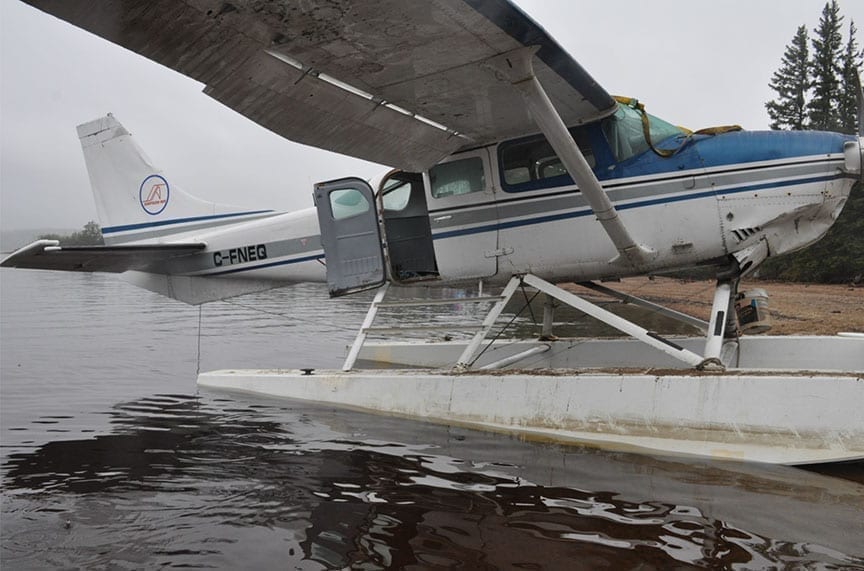An Aug. 16 plane crash that killed three people was marked by a "significant safety issue" in Cessna 206 planes that has claimed eight other lives in five similar accidents in Canada in the U.S, a letter from the Transportation Safety Board of Canada shows.

A Simpson Air Cessna U206G floatplane took passengers on a sightseeing flight from the Fort Simpson Airport to Virginia Falls and Little Doctor Lake. During landing on Little Doctor Lake, the aircraft lost control as the right wing contacted the surface of the lake.
The plane nosed over and came to rest inverted and partially submerged. The recovered aircraft had all doors closed and in the locked position.
The wing flaps were at a 20 degree angle, blocking the forward portion of the rear cargo door, wrote Natacha Van Themsche, director of investigations for the Air Transport Safety Board of Canada in a Feb. 18 letter to Transport Canada.
Prior to this accident, eight people have died in five accidents in the U.S. and Canada as a result of extended flaps blocking the rear double door, she wrote.
"As shown in this occurrence, without functional exits, the time required to exit the aircraft may increase, which in turn increases the risk of death in time-critical situations, such as when the aircraft is submerged or there is a post-impact fire," wrote Van Themsche.
The August crash killed three people and left two survivors SA����Ӱ�Ӵ�ý� a pilot and one passenger who were able to escape the submerged plane through the window of the front left door and on to the floats. Rescue efforts by the pilot to save the three remaining passengers failed.
"The pilot subsequently dove to assist the remaining passengers, but was unable to open the doors from outside the aircraft because they were locked from the inside," said Van Themsche.
All occupants were wearing lap belts. Shoulder harnesses were available to the pilot and front passenger, but it is not known if they were used on the flight, she said.
The impact force was "well within the range of human survivability" and no passengers were injured to the point of being immobilized.
Geoffrey Dean, 33, of Castor, Alta., Stewart Edelman, 72, of Saskatoon, Sask., and Jean Edelman, 72, also of Saskatoon,, were killed in the crash, stated NWT CoronerSA����Ӱ�Ӵ�ý�s Office in an Aug. 16 news release.
Cargo door failure replicated repeatedly
During certification, Transport Canada determined that the rear cargo door could not be considered an emergency exit because "it was not readily accessible and the opening was not simple and obvious," the letter states.
All variants of the Cessna 206 are certified under U.S. Civil Air Regulations which mandate that all emergency exits must be clear and unobstructed. To open the rear double cargo door on the model of aircraft that crashed it is necessary to manipulate the handle found on the front edge of the door.
"Operation of the double cargo door is further complicated when the flaps are deployed," said Van Themsche.
The forward cargo door can only be opened eight centimetres before it comes into contact with the flap.
In 1998, Cessna Aircraft Company started production of the Cessna 206 after a 12-year hiatus. It was mostly the same as the model produced up until 1986. It incorporated placards and modification to the cargo door handle size and location.
Between 1999 and 2003, Transport Canada, U.S. Federal Aviation Administration and Cessna worked to design an alternative to retrofit its 206 fleet.
The "matter was dropped" when they could not find an acceptable solution to up the occupant limit from five passengers, wrote Van Themsche.
In Canada, 190 Cessna U206 aircraft, 50 Cessna TU206 aircraft and 11 Cessna 206H aircraft are in private and commercial operation.
The only defence to help an occupant escape a submerged aircraft in situations where escape is time-critical, such as with post-impact fire or submersion, are restraint systems to reduce impact injury and pre-flight safety briefings.
The letter states that "more defences" are needed to mitigate hazards for passengers attempting to escape submerged Cessna 206 aircraft.
"(Transport Canada) may wish to reassess the suitability of the rear double cargo door as an emergency exit, as described in certification requirements for all Cessna 206 series aircraft," wrote Van Themsche.
Five incidents take eight lives
In July 1989 at Keefer Lake, Ont., a passenger originally seated in the front of a Cessna TU206G drowned in the rear of the aircraft, inverted during landing.
In July 1996, at Rivière des Prairies, Que., a Cessna U206F capsized on takeoff. The pilot and three passengers drowned in the rear of the aircraft as the pilot tried to open the rear cargo doors.
In June 1997, at Carroll Lake, Ont., a Cessna TU206G capsized on landing after touching down with the wheels extended on the amphibious floats. Two passengers were unable to exit the aircraft and drowned.
On 28 June 2003, at Lac Lemoine, Que., a Cessna U206F flipped over during landing. A passenger drowned after attempting to exit the aircraft rear, contrary to pilot instructions.
On 10 July 2012, at Beluga Lake, near Homer, Alaska, a Cessna U206G capsized on landing. The crash deformed the airframe and jammed the pilot's door. The pilot and three of four passengers bent the forward half of the cargo door enough to squeeze through a small space. The remaining passenger drowned. Autopsy showed that blunt force trauma injuries rendered the passenger incapable of using the exit.


